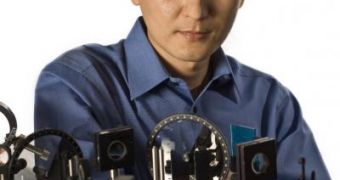A team of scientists from the US Air Force Office of Scientific Research, led by Dr. Chunlei Guo, recently announced the development of a new method of treating metal, which involves tremendously intense bursts of laser. If a shiny piece of metal is bombarded with the laser pulses, it eventually changes its color to black, without the use of any dyes, and begins absorbing all radiations that are aimed at it. The innovation could open the way for the creation of new types of aircraft, the AFOSR scientists believe.
“With the creation of the black metal, an entirely new class of material[s] becomes available to us, which may open up a whole new horizon for various applications. To do this, we looked at the reverse process of light absorption or light radiation and transformed the incandescent lamp into a bulb that glows twice as brightly as a regular light source, while consuming the same amount of energy,” Guo explains.
The way the team modifies the metal is by subjecting it to femtosecond laser bursts, lasting only a few quadrilionths of a second. The force of the laser is so great, that Guo likens it to the entire power of the North American grid, focused in less than a second on a surface the size of a needle point. The end-result is the formation of nano- and micro-structures that significantly alter the way in which light and other forms of electromagnetic radiation disperse off the metal's surface.
Additionally, the team noticed that the behavior of liquids on the new surfaces also changed dramatically. Because the nanostructures attach themselves to the liquid molecules faster than the water molecules, for example, attach to each other, the liquid is spread evenly across the surface. This could be used, in practice, to cool computers and other heat systems on airplanes, essentially giving them the dominant position in any air-to-air confrontation.
Guo and his researchers are currently focusing their efforts on discovering a method of transforming shiny metal into black metal faster. It now takes about half an hour to turn a quarter-sized piece of material into the new stuff, which is not fast enough, if the AFOSR is to adequately respond to the rigors of modern warfare.

 14 DAY TRIAL //
14 DAY TRIAL //